The Sandy Bridge Review: Intel Core i7-2600K, i5-2500K and Core i3-2100 Tested
by Anand Lal Shimpi on January 3, 2011 12:01 AM ESTThe 6-series Platform
At launch Intel is offering two chipset families for Sandy Bridge: P-series and H-series, just like with Lynnfield. The high level differentiation is easy to understand: P-series doesn’t support processor graphics, H-series does.
There are other differences as well. The P67 chipset supports 2x8 CrossFire and SLI while H67 only supports a single x16 slot off of the SNB CPU (the chip has 16 PCIe 2.0 lanes that stem from it).
While H67 allows for memory and graphics overclocking, it doesn’t support any amount of processor overclocking. If you want to overclock your Sandy Bridge, you need a P67 motherboard.
6Gbps
Had SSDs not arrived when they did, I wouldn’t have cared about faster SATA speeds. That’s how it worked after all in the evolution of the hard drive. We’d get a faster ATA or SATA protocol, and nothing would really change. Sure we’d eventually get a drive that could take advantage of more bandwidth, but it was a sluggish evolution that just wasn’t exciting.
SSDs definitely changed all of that. Today there’s only a single 6Gbps consumer SSD on the market—Crucial’s RealSSD C300. By the middle of the year we’ll have at least two more high-end offerings, including SandForce’s SF-2000. All of these SSDs will be able to fully saturate a 3Gbps SATA interface in real world scenarios.
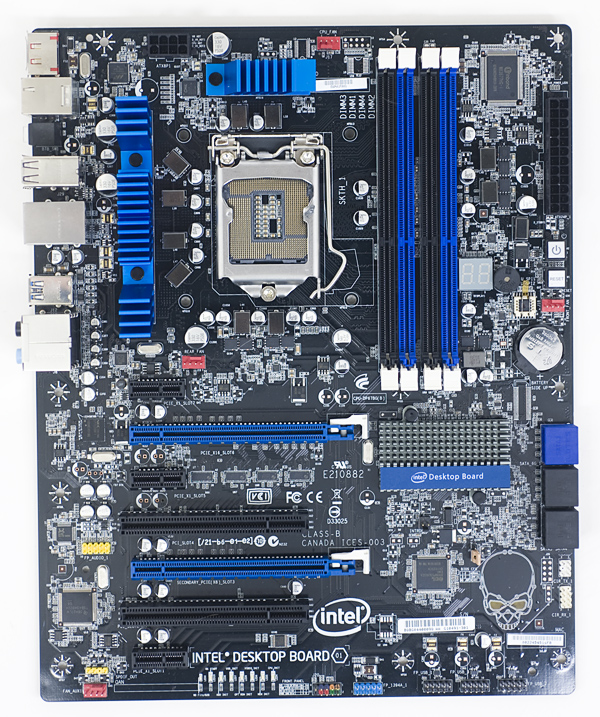
Intel's DP67BG—The blue SATA ports on the right are 6Gbps, the black ones are 3Gbps
To meet the soon to be growing need for 6Gbps SATA ports Intel outfits the 6-series PCH with two 6Gbps SATA ports in addition to its four 3Gbps SATA ports.
I dusted off my 128GB RealSSD C300 and ran it through a bunch of tests on five different platforms: Intel’s X58 (3Gbps), Intel’s P67 (3Gbps and 6Gbps), AMD’s 890GX (6Gbps) and Intel’s X58 with a Marvell 9128 6Gbps SATA controller. The Marvell 91xx controller is what you’ll find on most 5-series motherboards with 6Gbps SATA support.
I ran sequential read/write and random read/write tests, at a queue depth of 32 to really stress the limits of each chipset’s SATA protocol implementation. I ran the sequential tests for a minute straight and the random tests for three minutes. I tested a multitude of block sizes ranging from 512-bytes all the way up to 32KB. All transfers were 4KB aligned to simulate access in a modern OS. Each benchmark started at LBA 0 and was allowed to use the entire LBA space for accesses. The SSD was TRIMed between runs involving writes.
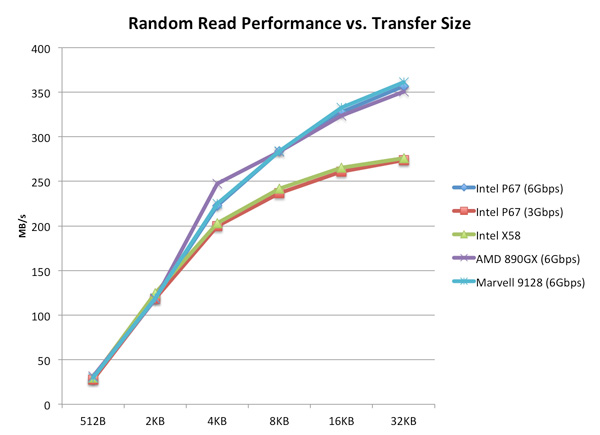
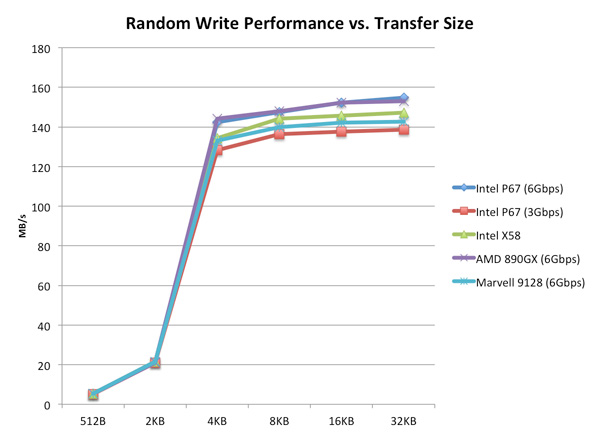
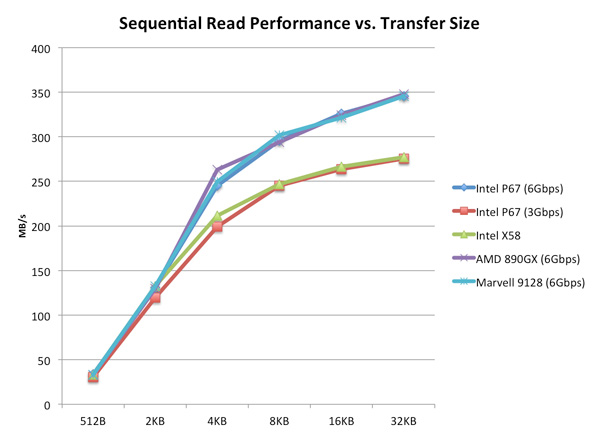
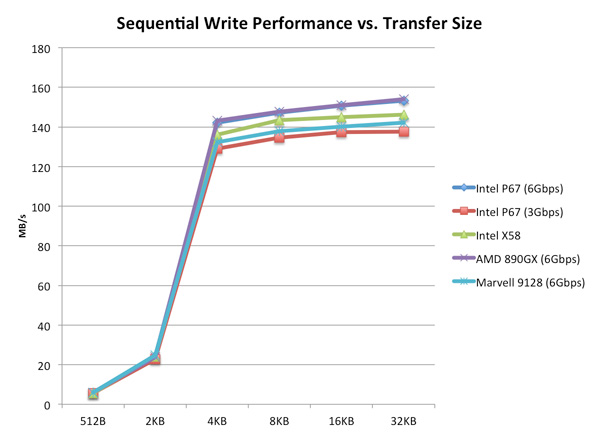
Among Intel chipsets I found that the X58 has stellar 3Gbps SATA performance, which is why I standardize on it for my SSD testbed. Even compared to the new 6-series platform there are slight advantages at high queue depths to the X58 vs. Intel’s latest chipsets.
Looking at 6Gbps performance though there’s no comparison, the X58 is dated in this respect. Thankfully all of the contenders do well in our 6Gbps tests. AMD’s 8-series platform is a bit faster at certain block sizes but for the most part it, Intel’s 6-series and Marvell’s 91xx controllers perform identically.
I hate to be a bore but when it comes to SATA controllers an uneventful experience is probably the best you can hope for.


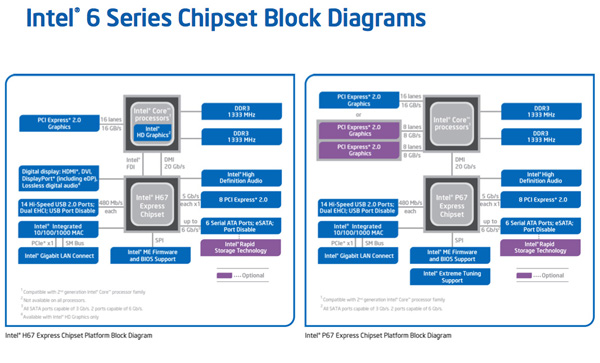








283 Comments
View All Comments
saikyan - Thursday, January 6, 2011 - link
"perhaps we should return to just labeling these things with their clock speeds and core counts? After all, it’s what Apple does—and that’s a company that still refuses to put more than one button on its mice. Maybe it’s worth a try."I hate to sound like the resident Mac fanboy (I'm platform agnostic) but I want to point out:
1. Apple sells by trim and display, they don't really make a big deal of the CPU (probably because they stick to low-end and midrange CPUs)
2. They have been shipping multi-button mice for nearly six years now. Come on!
vol7ron - Friday, January 7, 2011 - link
- gtx460 image quality definitely the worst- 6870 image quality next
- quicksync/snb image quality are the best (marginally better than 6870); I did notice some color loss in the flowers behind the umbrella when I zoomed in on the quicksync picture, so I'd have to give SNB the title in terms of quality. QuickSync gets the title in terms of performance.
nitrousoxide - Monday, January 10, 2011 - link
lmaoBurticus - Monday, January 10, 2011 - link
My last Intel cpu was a prescott 2.4ghz P4 OC'd to over 3ghz... back in 2004? My last 3 main system builds all AMD.... I was thinking about going to an X6 in the near future, now I guess maybe not. My price point is pretty much $200 for the cpu + motherboard so maybe I'll have to wait a couple months.Suddenly my 2 year old Phenom II seems very, very slow...
magnusr - Tuesday, January 11, 2011 - link
I just received my 2600K. It only had the normal fan. No special heatsink/fan for the 2600K. The same heatsink as the rest....This is a fraud since I placed my decision to take 2600K instead of the 2500K based on the better heatsink and the cache.
mmcnally - Tuesday, January 11, 2011 - link
Same here.. Very disapointed as I would have purchased a better heatsink if I knew. I guess I'll just do the install with the standard crap HS and hold off on over-clocking until I get a better one.swing848 - Tuesday, January 11, 2011 - link
Many of us are using older equipment. And, for those of us with limited funds it would have been nice if you would have added the Intel Q9650 and run all game benchmarks at 3.4GHz [ the speed of the 2600K], except for the default 3.6GHz speed of the X4 975BE, leave it there.I have a QX9650 that I purchased from eBay and it does 4GHz+ with ease, in a Gigabyte P35-DS3R motherboard, even with my ancient cooler [Thermalright XP-90] that I pulled from a socket 478 motherboard [$5 adapter].
Note: I lapped the XP-90 with a slight convex shape to better use with un-lapped CPUs.
In any event, a "quick and dirty" or simple overclock would have yielded at least some usable information. To save time, no need to try to get the maximum speed from all components.
As long as the CPUs were already overclocked, you could run all benchmarks at those speeds, not just games. Many of us overclock to get more for our money.
You included the ancient Q6600 at it's slow default speed - in some of the benchmarks. Why didn't you include it in all benchmarks?
Your normal benchmark page does not include a full, or nearly full, list of games and CPUs, so, comparisons are difficult to find, example here anandtech.com/bench/CPU/62
Where does this leave those of us with older equipment that is still chugging along?
Kell_sw - Thursday, January 13, 2011 - link
DRM inside the cpu? People is blind?. The sad thing, everybody is going to buy this.Sweeo - Friday, January 14, 2011 - link
I just bought a upgrade "kit" from an core 2 2.8 quad to i7 950 :(but I got 6 sata ports I noticed the new boards have 4+2
will the more advanced boards have more ?
Ahumado - Sunday, January 16, 2011 - link
I didn't see it discussed. Did I miss it?